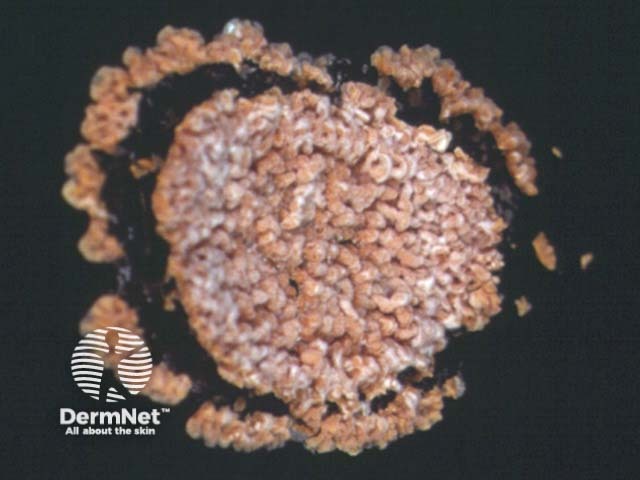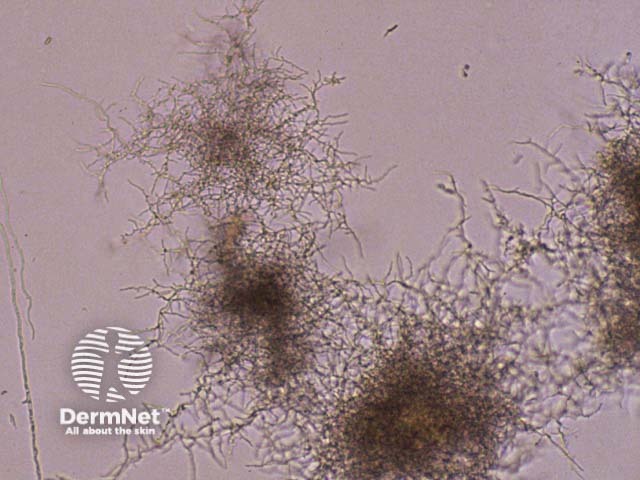Main menu
Common skin conditions

NEWS
Join DermNet PRO
Read more
Quick links
Nocardiosis — extra information
What is nocardiosis?
Nocardiosis is a rare infection caused by several species of bacteria from the genus Nocardia. These bacteria live in soil and are found worldwide. There are two main clinical forms of nocardiosis, disseminated and/or pulmonary infection and cutaneous infection.
Disseminated and/or pulmonary nocardiosis
This is the most common form of nocardiosis and the responsible bacteria are usually N. asteroides. Humans become infected by breathing in the organism. Many patients with disseminated and/or pulmonary nocardiosis have immunodeficiency, such as chronic (long-term) lung disease, HIV infection, or long-term use of immunosuppressant medications. The disease often begins in the lungs but can spread to involve any organ, most commonly the brain (causing brain abscesses), and skin in 10 to 30% of cases.
Primary cutaneous nocardiosis
This is usually caused by N. brasiliensis and primarily affects individuals who are otherwise healthy. The bacteria enter the body via a skin wound, such as a cat scratch or a puncture wound from a thorn. Three types of primary cutaneous nocardiosis have been described:
- Superficial skin infection
- Lymphocutaneous infection
- Mycetoma (click on the link for details)
Disseminated and/or pulmonary nocardiosis can also spread to involve the skin; in these cases N. asteroides is often responsible. Conversely, primary cutaneous disease can rarely spread to involve the lungs, brain, and other organs.
In the United States, an estimated 500-1000 new cases of Nocardia infection occur each year. Worldwide rates of nocardiosis vary by country. Middle-aged men performing outdoor labour are at highest risk of infection. Other species of Nocardia less commonly cause infection, such as N. farcinica, N. nova, N. transvalensis, and N. pseudobrasiliensis.
What are the clinical features of nocardiosis?
Disseminated and/or pulmonary nocardiosis
Disseminated and/or pulmonary nocardiosis often begins with a fever, cough, and chest pain. If the infection spreads to the brain, symptoms such as headache, lethargy, confusion, seizures, and sudden onset of paralysis may occur.
Primary cutaneous nocardiosis
In primary cutaneous nocardiosis, there is usually a history of trauma to the skin several days to several months prior.
- Superficial skin infection – This is characterised by pus-filled blisters, ulcers, abscesses, or cellulitis. Pyoderma (pus-filled crusting lesion that heals with ulcer formation) may be present. Fever is common, but lymph nodes are not usually enlarged. This condition cannot be distinguished clinically from infections caused by more common organisms, such as Staphylococcus aureus. Less common superficial infections include primary eye infection; this is an uncommon complication of cataract surgery or LASIK eye surgery.
- Lymphocutaneous infection – This is rare. An ulcerating lump is found at the site of the injury, followed by spreading inflammation and subcutaneous nodular (lumpy) lesions along the lymphatic chain. Pus may drain from the lesions and other nearby lymph nodes may be enlarged.
How is nocardiosis diagnosed?
Diagnosis can be difficult, as Nocardia grow slowly in the laboratory. Blood tests for antibodies against Nocardia are unreliable and not available commercially. Current diagnostic tests include:
- Gram staining and modified acid-fast staining from smears of draining areas or skin biopsy specimens.
- Nocardia may take up to 2-3 weeks to grow in the laboratory; specimens from multiple clinical sites should be submitted.

KOH microscopy of

Nocardia in culture

Nocardia in agar
What is the treatment for nocardiosis?
Long-term antibiotic therapy is required to prevent relapse; suggested treatment duration ranges from 6 weeks for minor infections, to 1 year for severe disseminated disease.
- The most commonly used antibiotic is trimethoprim-sulfamethoxazole (TMP-SMZ).
- Some species of Nocardia are resistant to TMP-SMZ, so antibiotic susceptibility testing is important.
- Patients with severe disseminated disease require intravenous antibiotics such as amikacin in combination with imipenem.
Surgical drainage or excision is often required for abscesses.
What is the outcome for patients with nocardiosis?
Approximately 10% of cases of uncomplicated pulmonary disease are fatal. The case-fatality rate increases with disseminated disease or brain abscesses, particularly in patients with impaired immunity. Cutaneous nocardiosis is rarely fatal, but long-lasting mycetomal infection can be significantly disfiguring.
References
- Saubolle MA, Sussland D. Nocardiosis: review of clinical and laboratory experience. J Clin Microbiol. 2003 Oct;41(10):4497–501. PubMed
- CDC — Nocardiosis
- Medscape Reference — Nocardiosis
On DermNet
